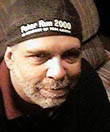|
|
This topic comprises 2 pages: 1 2
|
|
Author
|
Topic: Was there a home VTR before Beta?
|
|
|
|
|
|
|
|
|
|
|
|
|
|
|
|
|
|
|
Jesse Skeen
Phenomenal Film Handler

Posts: 1517
From: Sacramento, CA
Registered: Aug 2000
|
 posted 06-23-2005 02:26 AM
posted 06-23-2005 02:26 AM




I've got 2 Cartrivision machines now, but neither are up to the task of actually getting a picture on the screen. Not sure what the exact problem is, but hoping I can eventually salvage one working unit out of the two. I've got a few rental tapes that can only be rewound with a special machine the rental stores had, though the tapes seem to have been taken apart to defeat that mechanism, and I've got one home-recorded tape that is supposedly a live recording of President Nixon's resignation. We'll just have to see how well the tapes have actually held up. I've got a few Beta tapes going back to 1977 that look like they were recorded yesterday though. (It took me until 1985 to convince my parents to get a VCR, though at least it was one of the first Hi-Fi models that could record broadcast stereo. I've been buying up all the older tapes I can find at the flea markets and thrift stores though and have found some treasures.)
Another odd 70s video format was Quasar's Great Time Machine, which used tapes bigger than VHS, circa 1976. I have a machine but no tapes, so I don't know if it works. There was a format from Sanyo called V-Cord that used smaller tapes that were shaped like 8-tracks but had a supply and take-up reel inside next to each other. I found some unused blanks once so I bought one to open up and one to keep sealed, never seen a machine though- there was one on Ebay a couple months ago but it went for more than I could afford to pay.
BTW anyone here wanna trade DVDs of old (pre-1980) TV recordings with commercials? I've been transferring all the old stuff I've found with my Philips DVD recorder, then duplicating them on my computer. I've got one disc put together with TV station sign-offs, mostly from Sacramento in the mid-80s but I've got one for KABC in 1978 and a CBS station in Roswell, NM too. Although I despise what cable TV has become now, I've also put together a disc with older movie intros and previews from HBO, Showtime and a number of defunct pay channels such as MovieVision and The Z Channel, which you had to rent a microwave antenna and receiver to get.
| IP: Logged
|
|
Bruce Hansen
Jedi Master Film Handler

Posts: 847
From: Stone Mountain, GA, USA
Registered: Dec 1999
|
 posted 06-25-2005 08:51 PM
posted 06-25-2005 08:51 PM




Many years ago Ampex tried to market a 1" B&W VTR (model 6000) to consumers. I remember seeing them in several stores, but it was large and heavy, and hard to work, so it did not sell. Then Sony tried to sell a 1/2" B&W pre EIAJ that did skip field scanning (in this case it recorded every other field, and then played each recorded field back twice), it did not sell well either. When the EIAJ models came out, they sold the old skip field units out at half price. I talked my parents into getting me one for Christmas. I remember telling friends that I had a video recorder. They would look at me strangely, and ask "what can you do with that?" I would explane that I can time shift showes that are on when I am not going to be home, if there are two showes on at the same time that I want to watch, I can watch one, and tape the other to watch later, and I can tape my favorit showes, and movies, and watch them any time I wanted to. About this time they would be asking where they could get one of these things. I remember thinking that if someone could make an easy to use VTR, at a price people could afford, they could sell a lot of them.
Mark, I enjoyed to site with all the old VTRs on it. It's nice to know there is someone out there that has even more old strange VTRs laying around than I do.
| IP: Logged
|
|
|
|
|
|
Phil Blake
Jedi Master Film Handler

Posts: 558
From: esperance western australia
Registered: Nov 2003
|
 posted 11-28-2005 09:45 AM
posted 11-28-2005 09:45 AM





An interesting thread, I did some ressearch into this and discovered that not only was Tweety Bird colored PINK in 1942 cartoons but it was in 1956 The first practical videotape recorder (VTR) was developed by the AMPEX Corporation in 1951.
The first commercially-feasible ones (with 2 inch tape reels) were sold for $50,000 in 1956.
1963 Ampex began to offer its first consumer version of a videotape recorder, sold through the Neiman-Marcus Christmas catalogue for $30,000 - a non consumer-friendly price.
1964 Sony began marketing the first reel-to-reel VTR designed specifically for home use in 1964.
1967 Sony introduced a portable (but bulky), expensive, out-of-studio video camera system (or video tape recorder - VTR) called the Portapak -- it inaugurated the modern era of video.
1969 Sony introduced a new device -- the videocassette recorder (VCR).
1972 The AVCO Cartrivision system (for CARTRIdige teleVISION) was a combination receiver / recorder / playback unit. It was also the first videocassette recorder to have pre-recorded tapes of popular movies (from Columbia Pictures) for sale and rental -- three years before Sony's Betamax VCR system emerged into the market. However, the company went out of business a year later.
1972 Sony introduced the U-Matic line of video cassette recorders.
1975 The Sony Corporation introduced the 1/2 inch Betamax video format and videocassette recorder (VCR) for consumer home use, with the capability of recording up to one hour.
1976 JVC introduced the VHS (video home system) 1/2 inch video format to compete with Sony's Betamax system. In 1977, RCA began marketing the first VCRs in the United States based on JVC's system, capable of recording up to four hours. By now, Japanese manufacturers had taken over the VCR market.
and there we have it ............ i still can't believe tweety was pink!
| IP: Logged
|
|
|
|
|
|
All times are Central (GMT -6:00)
|
This topic comprises 2 pages: 1 2
|
Powered by Infopop Corporation
UBB.classicTM
6.3.1.2
The Film-Tech Forums are designed for various members related to the cinema industry to express their opinions, viewpoints and testimonials on various products, services and events based upon speculation, personal knowledge and factual information through use, therefore all views represented here allow no liability upon the publishers of this web site and the owners of said views assume no liability for any ill will resulting from these postings. The posts made here are for educational as well as entertainment purposes and as such anyone viewing this portion of the website must accept these views as statements of the author of that opinion
and agrees to release the authors from any and all liability.
|

 Home
Home
 Products
Products
 Store
Store
 Forum
Forum
 Warehouse
Warehouse
 Contact Us
Contact Us




 Printer-friendly view of this topic
Printer-friendly view of this topic


















